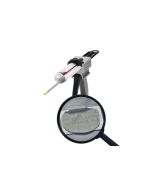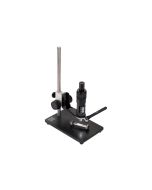8400K Optical Micrometer
The 8400K Optical Micrometer is a portable inspection microscope with depth measurement capability. It quickly and accurately measures the depth of scratches, fractures, cracks, crazing, corrosion pits, scribe lines, and other surface damage. The Optical Micrometer is easy to operate and requires no special training or expertise. It is durable, portable, can be easily calibrated in-house, and has no shelf life concerns.
Typical applications:
- Fast depth measurement
- Recognize surface structure
- Width measurement
- Tolerance determination
The Micrometer can be used on flat or curved surfaces, metals, plastics, composites, painted or chemically treated finishes, and transparencies. The Micrometer is capable of magnifications of 40X – 200X with depth measurements at an accuracy of +/- 0.001”.
In a cost-conscious environment, maintainers are under more pressure than ever to keep parts in service. Proper defect classification has a huge impact on resources, readiness and safety, so obtaining accurate measurements quickly and reducing inspection discrepancies is critical. The ability to make fast, reliable and repeatable measurements of surface damage presents a significant opportunity for cost savings by maximizing part life cycles.
Proper dispositioning the first time a part is checked can avoid lengthy repairs and reduce down time waiting for new parts. Repeatability ensures the validation of results, reducing delays that occur
Many standards and technical publications set maximum limits for surface damage on critical components, but the methods most commonly used for measuring surface damage are unreliable and impractical.
Ball scribes, pit gages, dial indicators and other probe-style gages may be cheap and easily portable but are problematic in a number of ways. The graduated dial indicator is difficult to read and can result in inaccurate measurements. It can also be difficult to hold the gage steady and at a consistent angle, making repeatability poor on anything but a very flat surface. Even on a flat surface, the deepest part of the damaged area may be narrower than the probe. In this case, lack of visual confirmation often results in incorrect defect classification.
| Specifications | Fields of application |
Application |
|
|
|






